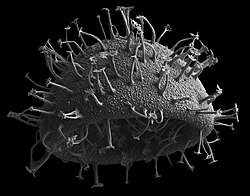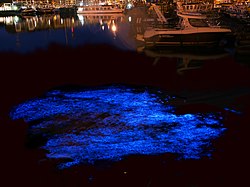Dinoflagellate
The dinoflagellates are a large group of flagellate protists. About half are photosynthetic, the rest are mostly heterotroph predators of other protists. The ones which are photosynthetic are sometimes loosely called 'algae'; the one which are predators are sometimes loosely called 'protozoa'.
| Dinoflagellate | |
|---|---|

| |
| Ceratium furca | |
| Scientific classification | |
| Domain: | |
| Kingdom: | |
| Superphylum: | |
| Phylum: | Dinoflagellata Bütschli 1885
|
They have been classified as an order, a class and a phylum by different authors. Research is being done on their relationships.
Most are marine plankton, but they are common in fresh water habitats as well. Their populations vary with sea surface temperature, salinity, and depth. The group includes many symbionts and bioluminescent species.
About 1,555 species of free-living marine dinoflagellates are described at present.[1] The latest estimates suggest a total of 2,294 living dinoflagellate species, which includes marine, freshwater and parasitic dinoflagellates.[2]
Biology
Zooxanthellae
Some dinoflagellates are zooxanthellae: endosymbionts of marine eukaryotes, and animals such as anthozoan corals. These reef-building corals largely depend on them. Other organisms which can host zooxanthellae include jellyfish, clams, foraminifera, sea slugs i.e. nudibranchs, and also ciliates and radiolaria.
Red tides
Dinoflagellates are responsible for the 'red tides' which may poison fish. They sometimes bloom in concentrations of more than a million cells per millilitre. Some species produce neurotoxins, which in such quantities kill fish and accumulate in filter feeders such as shellfish, which in turn may pass them on to people who eat them. This phenomenon is called a red tide, from the color the bloom imparts to the water. Not all dinoflagellate blooms are dangerous. Bluish flickers visible in ocean water at night often come from blooms of bioluminescent dinoflagellates, which emit short flashes of light when disturbed.
Classification
Although classified as eukaryotes, the dinoflagellate nuclei lack some key features of eukaryotic nuclei. In fact, Dodge called the dinoflagellate nucleus mesokaryotic, because it had intermediate characteristics between the coiled DNA areas of prokaryotic bacteria and the well-defined eukaryotic nucleus.[3] This group, however, does have typically eukaryotic organelles, such as Golgi complexes, mitochondria and chloroplasts.
The group contains many complex organelles and life styles. Some have structures rather like vertebrates eyes; some have nematocysts; some live as plasmodia (multinucleate forms); some have two flagella; photosynthetic dinoflagellates contain a "bewildering array" of plastid types; and the whole of their genetics and cell biology is eccentric.[4]
Fossils
Fossil dinoflagellates are important in stratigraphy, the dating and correlation of strata. During their life, dinoflagellates have a mobile planktonic form and a resistant cyst phase which enables them to survive over winter in sediment. Only the cyst gets fossilised. Their first certain appearance is in the Silurian period, with a big radiation in the Mesozoic era.[5]p440 They are classified as Phylum Dinomastigota by Margulis and colleagues.[6]
Dinoflagellates leave fossil dinocysts. These have a long geological record: the earliest (lowest) occurrence is from the mid-Triassic.[7] Geochemical markers suggest a presence in the early Cambrian.[8]
DinoflagellateRed Tides Media
1. Ornithocercus; 2. diagram; 3. Exuviaella; 4. Prorocentrum; 5, 6. Ceratium; 7. Warnowia; 8. Citharistes; 9. Polykrikos
Dinophytic microalga isolated from sediments of Amur Bay
Long exposure image of bioluminescence of N. scintillans in the yacht port of Zeebrugge, Belgium
Kayaking in the Bioluminescent Bay, Vieques, Puerto Rico
Resting cysts of Scripsiella sp. (a), Alexandrium pseudogoniaulax (b), Protoceratium reticulatum (c), A. taylori (d), A. tamarense (e), Protoperidinium oblongum (f), Kryptoperidinium triquetrum (g), and Gymnodinium catenatum (h). Scale bar: 10 μm.
Unknown dinoflagellate under SEM (Dinophyceae)
Related pages
References
- ↑ Gómez F. 2005. "A list of free-living dinoflagellate species in the world's oceans". Acta Botanica Croatica. 64 (1): 129–212.
- ↑ Gómez F. 2012. (2012). "A checklist and classification of living dinoflagellates (Dinoflagellata, Alveolata)" (PDF). CICIMAR Océanides. 27 (1): 65–140. doi:10.37543/oceanides.v27i1.111. Archived from the original (PDF) on 2013-11-27. Retrieved 2015-06-16.
- ↑ Steidinger K.A. and Jangen K. 1997. Dinoflagellates. In: Tómas C.R. Identifying marine diatoms and dinoflagellates. Academic Press. p387–584
- ↑ "Tree of Life project". Archived from the original on 2012-10-13. Retrieved 2010-03-09.
- ↑ Levin, Harold. 2006. The Earth through time. Wiley, Hoboken N.J.
- ↑ Margulis L. Schwartz K.V. & Dolan M. 1999. Diversity of life: the illustrated guide to the five kingdoms. Jones & Bartlett, Boston, p88.
- ↑ MacRae RA, Fensome RA, Williams GL (1996). "Fossil dinoflagellate diversity, originations, and extinctions and their significance". Can. J. Bot. 74 (11): 1687–94. doi:10.1139/b96-205. ISSN 0008-4026.
- ↑ Moldowan JM, Talyzina NM (August 1998). "Biogeochemical evidence for dinoflagellate ancestors in the early cambrian". Science. 281 (5380): 1168–70. Bibcode:1998Sci...281.1168M. doi:10.1126/science.281.5380.1168. PMID 9712575.






